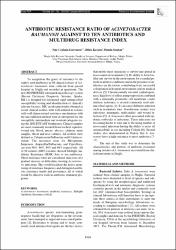ANTIBIOTIC RESISTANCE RATIO OF ACINETOBACTER BAUMANNII AGAINST TO TEN ANTIBIOTICS AND MULTIDRUG RESISTANCE INDEX
Abstract
To assignation the grade of resistance to the widely used antibiotics in 50 clinical isolates of Acinetobacter baumannii were collected from special hospital in Mugla and recorded at specimens. The new BD PHOENIX automated microbiology system (Becton Dickinson Diagnostic Systems, Sparks, Md.) is designed for automated rapid antimicrobial susceptibility testing and identification of clinically relevant bacteria. MIC results previously obtained in recent clinical isolates with well-defined in isolates with well-characterized resistance mechanisms with the microdilution method were re-interpreted for the susceptible, intermediate and resistant categories using the 2012 EUCAST breakpoints. Clinical samples are most commonly isolated from tracheal aspirates, wound site, blood, mucus, abscess, catheter, urine samples, throat and nose cultures. All isolates were defined as Cefoperazone/Sulbactam and Colistin resistant. The resistance rates for Meropenem, Imipenem, Ampicillin/Sulbactam, and Ciprofloxacin were 96%, 96%, 94% and 94% respectively. All of 50 isolates (100%) isolates showed Multiple Antibiotic Resistance (MAR) four to ten antibiotics. These resistance rates are considered indicators of a gradual increase in difficulties treating Acinetobacter infections. This would facilitate the active monitoring of resistance frequency and distinguish antibiotic resistance trends and prevalence, all of which would be effective tools in antibiotic treatment programs.


















